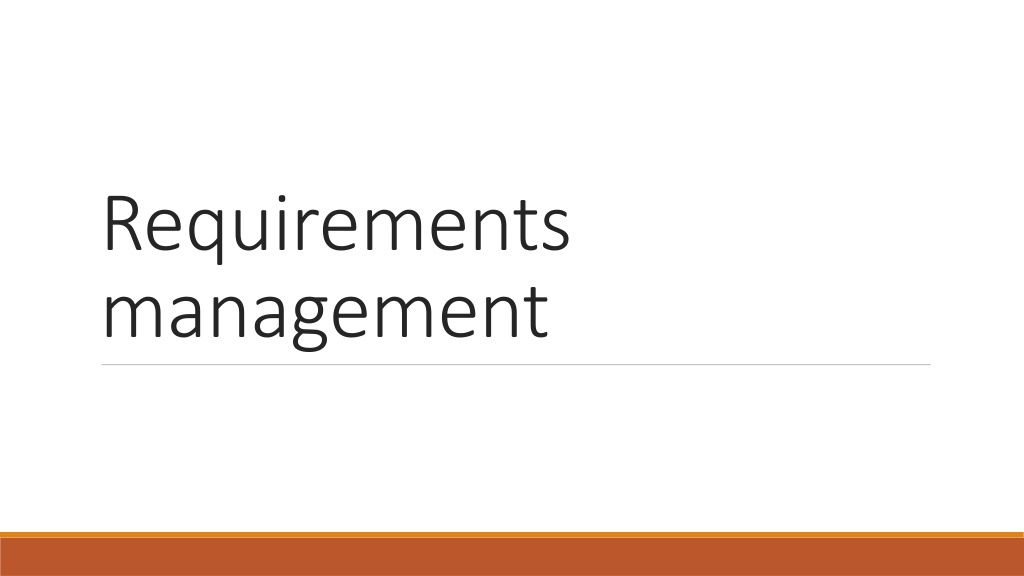Importance of Requirements Management in Project Success
Requirements management is crucial for project success, involving careful consideration of various requirement types such as functional, performance, constraints, and more. Clear, consistent, and verifiable requirements are essential, along with understanding the origins, impacts, and alternatives for each requirement. This process ensures that all stakeholders are aligned and that project goals are met effectively through comprehensive requirement knowledge and strategy implementation.
Download Presentation

Please find below an Image/Link to download the presentation.
The content on the website is provided AS IS for your information and personal use only. It may not be sold, licensed, or shared on other websites without obtaining consent from the author. Download presentation by click this link. If you encounter any issues during the download, it is possible that the publisher has removed the file from their server.
E N D
Presentation Transcript
Requirements management
Introduction REQUIREMENTS EXPRESS NEEDS In the whole project lifecycle, there must be careful thought to requirements this is necessary for the success of the project.
REQUIREMENT types Functional : what function must have to satisfy the needs. Performance : How it has to satisfy the needs Constraints : cost, schedule, start and end dates ) Interface : definition of physical and non physical interfaces. Environmental : specific to the project, standards Others : human resources, integration,
Requirements criteria a) Clear and consistent, so easily understandable with one meaning. Capable of being met by the system being defined. b) Correct, verified for no mistakes c) Non ambiguous d) Single, (subject-verb-object) if possible. Requirements must not combine, characteristics, functions or other that can be breakdown. e) Complete the requirement must define all information to meet the objectives of the system f) Consistent individual requirements must not conflict with each other g) Traceability requirements should be traced back to a parent/source or a baselined document or identified as a self- derived requirement h) High level -> flexible, no indications on how to satisfy it i) Lower level can be verified by tests l) Lower level - feasible, so inside physical and engineering feasibility definition and the project constraints range. The requirement must be technically achievable within the allowed schedule and budget constraints
Requirements knowledge All requirements and requirement strategy must be understood for the project success: Origin what is it derived from? Solidity - How much is it necessary? Alternative exists? Impact - The quality or solidity of a derived or external requirement is essential in the development of a project Is it a guesstimate ? Does it have conservative factors added to it ? Is it based on formal legal requirements or simple operational aspects ?
First step Understanding the difference between fundamental, derived, and external requirements - Fundamental Requirements or Key Performance Parameters (KPP): Technical requirements that if not achieved would be considered a fundamental failure of the project - Derived Requirements on the project deliverables that evolve or are developed from other more fundamental requirements Resolution (fundamental) - vibrational stability (derived) - External Requirements (Stakeholders, Constraints). Requirements that are imposed external to the project that are not directly related to the KPPs but must be met Example: Safety specific rules - Environmental / Safety compliance standards
Second step: there is a hierarchy Project mission Solutions Scientific Objectives Scientific Requirements Baseline Solution (and alternatives) Science/Engineering requirements Breakdown in levels (PBS, WBS) Engineering specification
The hierarcy needs a requirements quality standard and traceability Example: Dune. June 2015
And loops. Constraints Schedule, legal, budget, policy, safety .. T R A D E Alternative 1 Alternative 2 Alternative 3 . . . Requirement 1 Requirement 2 Requirement 3 . . . System version n OBJECTIVES O F f Feedback: is it coherent with..
Quality process : description Requirements management plan With (typically): Scope Roles and Responsibilities Requirements management strategy and framework Type of requirements Validation and review Verification Traceability External Requirements
Traceability example. Metadata sheet Tier 1 Upward Traceability (GRD) Tier 2 Upward Traceability FRS ExistingRequirement Information TRS Downward Traceability Requirement Verification Verific ation Docum ent # Description Verified through specification and procurement contract with vendor. Tested after installed in beam line. A subset of supplies will be tested for conformance on a dummy load. The report will contain the QPM test procedure and the switcher full voltage test procedure. Verific ation Timefr ame T1 Document Name T2 Document Name Verific ation Status Requirem ent #2 Sub- Heading3 Requirement Statement4 TRS TC # Verification Method Verification T1 TC #Tier 1 Statement T2 TC #Tier 2 Statement TRS Name TRS Statement The Power Supply System for the cold solenoid magnets in the HWR, SSR1 and SSR2 shall provide a maximum of 80 amps of DC current. Magne t/Powe r Supply Commi ssioing Report Table 7.1 lists the maximum current requirements for the power supplies. During beam commi ssionin g Cryogenic Magnet Power Supplies No further upward traceability None F- 121.3.05- A001 Magnet PRD ED001 0226 TRS has yet to be written. Demonstrati on/Test NA TBD TBD Open

 undefined
undefined




























![Project Initiation Document for [Insert.Project.name] [Insert.Project.number]](/thumb/226757/project-initiation-document-for-insert-project-name-insert-project-number.jpg)